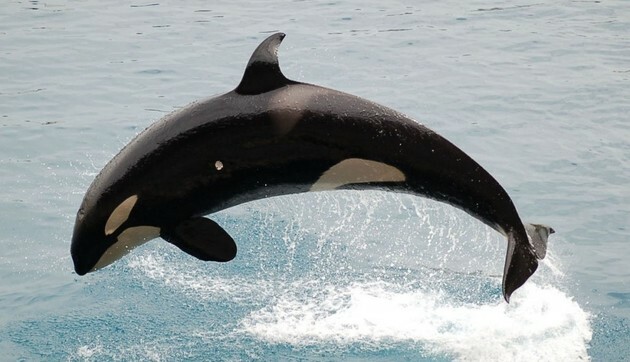The orca (orcinus orca) is a mammal that lives in cold water oceans and seas. Belonging to the Mammalia class, Cetacean order and the Delphinidade family, it is related to dolphins.
Killer whales are still related to the false orca. Both have a very similar body, and the main difference between them is in the shape of the head and the gray color that the false-orca presents.
Scientifically, the orca is not a whale, but a dolphin. However, it is not wrong to quote it as "orca whale", since dolphins and whales belong to the same order (Cetacea).
The main difference between whales and orcas would be in their skeleton and mouth. Killer whales have teeth, as do dolphins.
It is also known as the "killer whale", however, accidents involving humans have only been recorded in captivity. This fame is due, especially to films that feature the orca attacking other animals.
Orca Whale Characteristics
Orca whales are characterized by their colors. Its back is black and the underside and near the eyes white. In addition, every killer whale has a white spot behind its dorsal fin, allowing the identification of each individual.
The orca has a thick layer of fat that protects it from low temperatures, working as a thermal insulator.
She has a very high fin on her back. In males, the fins are triangular and tall, whereas in females they are curved.

Male orcas can be up to 10 meters long and weigh between 9 and 10 tons. The females, on the other hand, measure approximately 8.5 meters and weigh between 6 and 8 tons.
The puppies are born on average 2.5 meters long and weigh about 200 kg.
Habitat
Killer whales live in oceanic regions and most of the seas. They are more common in cold waters, such as the polar regions.

They live in deep water, but they are also frequently found on the surface and in coastal areas.
One of the most frequented places for orcas is the waters of the Antarctica. They are also found in the northeastern part of the basin of the Pacific, especially on the coast of Iceland and the northern coast of Norway.
Another very common animal in icy waters is the Penguin.
food
The orca's feeding involves several marine animals. The animals that are part of their diet are sharks, dolphins, turtles, sea lions and even other whales, mainly because of their strong dental arch.

The daily feeding of an orca can reach 250 kg. To meet this need, they have developed different hunting techniques, such as attacks on large pods of whales and chases on seals and dolphins.
When they are closer to the surface and shore, they swim at high speed to create waves on the water's surface and prevent seals and sea lions from swimming.
In polar regions, it is common to find Polar Bear feeding on the carcass of dead whales.
Behavior
Orca whales are very sociable. They normally live in groups and only separate during the mating period.
Living in a matriarchal society, they have their relationships around the oldest female in the group.

Communication between killer whales takes place through their own sounds, which are similar to whistles and screams. They also tap their fin in the water as a form of interaction.
The killer whale is very common in captivity. They are water park attractions for having playful behavior and an impressive size. In addition, its intelligence also stands out.
Orcas in Brazil
On the Brazilian coast, orcas have been seen more frequently, with reports since 1993.
Records point to occurrences of orcas on the coast of Rio Grande do Sul, Santa Catarina, São Paulo and Paraíba.
According to researchers, the orcas travel to the Brazilian coast to escape the winter, which can vary between February and October.
In Brazil, another species of whale that is frequently seen are the right whales and the humpback whale.
Curiosities
- the orca is the second mammal most found considering the entire geographic distribution of the planet, second only to man.
- The orca's gestation period ranges from 15 to 18 months.
- Killer whales have 50 teeth, which can crush the bones of other animals in just one bite.
- The oldest orca whale in the world, over 100 years old, died in 2017.
- It is estimated that their reproductive life starts around 10 years of age and goes up to 40 years old on average, when they enter menopause.
- Killer whales, along with women and another type of whale, are the only mammals that enter menopause.
Read too:
- The 10 biggest predators in the animal kingdom
- aquatic ecosystem
- animal Kingdom
- Whale
- Blue Whale

